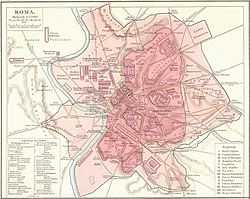Castra Peregrina
Coordinates: 41°53′04″N 12°29′39″E / 41.884531°N 12.494212°E
| Castra Peregrina | |
|---|---|
| Location | Caelian Hill |
| Built in | 1st Century AD |
| Built by/for | Augustus |
| Type of structure | Roman Barracks |
| Related |
List of ancient monuments in Rome |
 | |
The Castra Peregrina (“camp of the strangers”) was an ancient military barracks located in Rome upon the Caelian Hill.
Location and archaeology
The barracks are situated on the Caelian Hill between the Temple of the Deified Claudius and Neros’ Macellum Magnum. It is centrally located on a hill known for its’ housing of wealthy Romans. The fourth-century Regionaries list the Castra Peregrina in regio II.[1] The camp was discovered during digging for the foundations of a convent and hospital and partially excavated from 1904-1909.[2] It can now be found just south-east of the well preserved church S. Stefano Rotondo.
Function
As the name suggests, the barracks housed a garrison of peregrini; soldiers from the provincial armies detached for special services in Rome. These consisted of a majority of frumentarii[2] and inscriptions suggest that the Castra Peregrina acted as a central base for the distribution of these men throughout the unarmed provinces (inermes).[3] The frumentarii, who were likely based, and not only housed, at the Castra Peregrina, were initially involved in the provision supply service of Rome,[4] but were later employed as military couriers and members of the secret service.[5]
History
Richardson suggests that the brickwork demonstrates an Augustan origin with a second century A.D. rebuilding, probably under Severus,[2] and another rebuilding in third century A.D.,[6] however the earliest mention of the princeps peregrinorum (camp-commandant) in Rome was during the reign of Trajan.[7] It is also mentioned by Ammianus Marcellinus, showing that it was in use as late as the fourth century A.D.[8]
More information
Within the castra was a shrine (templum) of Jupiter Redux erected in honour of Severus and Mammaea by a centurio frumentarius.[9] A carving of the construction of the barracks was found at Ostia; on a column in the Square of the Corporations. In the initial excavation of the barracks, stone ships were also found; these were made by soldiers thanking the gods for protecting them from shipwrecks (see Fontana della Navicella) and provides further evidence of the spread of the barracks' frumentarii across the provinces.
See also
References
- ↑ Thayer, Bill (2000-03-20): “The Regionaries: A Fourth-Century Description of the XIV Regions of Rome” in LacusCurtius: Into the Roman World. Retrieved 2014-08-01
- ↑ 2.0 2.1 2.2 Richardson jr., L: A New Topographical Dictionary of Ancient Rome, JHU Press, 1992, p. 78
- ↑ Rankov, N.B.: “Frumentarii, the Castra Peregrina and the Provincial Officia” in Zeitschrift für Papyrologie und Epigraphik, vol. 80, 1990, p. 176
- ↑ Mann, J.C.: “The Organization of the Frumentarii” in ZPE, vol. 74, 1988, p. 149-150
- ↑ Historia Augusta (S.H.A): Life of Claudius; Life of Hadrian; Life of Commodus; Life of Macrinus
- ↑ Martin, Archer et al.: “A Third Century Context from S. Stefano Rotondo” in Memoirs of the American Academy in Rome, vol. 53, 2008, p. 216
- ↑ Baillie Reynolds, P.K.: “The Troops Quartered in the Castra Peregrinorum” in The Journal of Roman Studies, vol. 13, 1923, p. 168-189
- ↑ Thayer, Bill (2008-02-10): “Ammian: The History” in LacusCurtius: Into the Roman World. Retrieved 2014-08-01
- ↑ CIL VI.428 (inscription)